
Content
Welcome to the Club of Amsterdam Journal.
A third way: Self Sovereign Identity and Disposable Identities with Rob van Kranenburg
The COVID19 virus exposes not only the fragility of an economic system that cannot go on hold for even a fews months, the inadequacy of governance tools and the lack of faith of people in their leaders, but foremost it exposes the lack of fundamental trust of citizens all over the world in that what they paradoxically have in their hands most of the time: the smartphone.
Felix B Bopp
Founder & Chairman, Club of Amsterdam
Universal Peace Ambassador
Rewilding: lessons from the medieval Baltic crusades
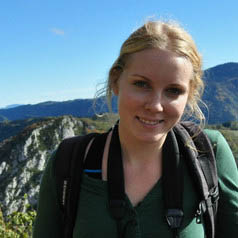
By Lisa Malm, Postdoctoral Fellow, Ecology and Environmental Sciences, Umeå University
Contributor: Darren Evans, Professor of Ecology and Conservation, Newcastle University

Erik Mandre/Shutterstock.comLisa Malm, Umeå University
After a particularly long week of computer based work on my PhD, all I wanted was to hike somewhere exciting with a rich wildlife. A friend commiserated with me – I was based at Newcastle University at the time, and this particular friend wasn’t keen on the UK’s wilderness, its moorlands and bare uplands, compared to the large tracts of woodland and tropical forests that can be found more readily abroad.
Luckily, I count myself among many who are charmed by the rolling heather moorlands and sheep grazed uplands, whose colours change beautifully with the seasons. But my friend had a point – there is something very different about many of the UK’s national parks compared to those found in much of the rest of the world: the British uplands are hardly the natural wilderness that many perceive.
These upland habitats are in fact far from what they would have been had they remained unaffected by human activity. In particular, grazing by livestock has been carried out for centuries. In the long run, this stops new trees from establishing, and in turn reduces the depth of soil layers, making the conditions for new vegetation to establish even more difficult. Instead of the woodlands that would once have covered large areas of the uplands, Britain is largely characterised by rolling hills of open grass and moorlands.
Government policy has long been to keep these rolling hills looking largely as they do now. But the future of the British uplands is uncertain. Regulations and government policy strongly influences land management, and the biodiversity associated with it. In fact, the management required to maintain British upland landscapes as they are now – management that largely involves grazing by sheep – is only possible through large subsidies. And due to Brexit, this may change. A new agricultural policy will soon replace the often-criticised Common Agricultural Policy (CAP).

What this will look like remains unclear. There are a range of competing interests in the uplands. Some wish to rewild vast swathes of the land, while others want to intensify farming, forestry and other commercial interests. The rewilders tap into the increased interest in restoring natural woodland due to its potential in carbon uptake, increased biodiversity and reintroduction of extinct species such as wolves and lynxes, while some farmers argue that this will be bad for the economy. The UK stands at a crossroads, and interests are rapidly diverging.
Whatever path is taken will obviously have an impact on the unique assemblages of upland plants and animals, many of which are internationally important. But upland birds and biodiversity have for a long time been on the decline. Whether rewilding is the answer to this or not has long been debated: some claim that we need to stop grazing animals to allow the natural habitat to reassert itself, while others claim that some species, such as curlews, rely on such grazing practises for their survival.
But our new research, published in the British Ecological Society’s Journal of Applied Ecology, provides the first experimental evidence to our knowledge, that stopping livestock grazing can increase the number of breeding upland bird species in the long term, including birds of high conservation importance, such as black grouse and cuckoo. This is interesting, as it is often argued that land abandonment can result in lower biodiversity and that livestock grazing is essential for maintaining it.
Our research shows that, depending on how the uplands are managed, there will be bird “winners” and “losers”, but overall when sheep have gone the number of bird species returning increases.
A subsidised landscape
Before going into the research itself, it’s important to consider the history of British upland land management. Truly “natural” habitats in the UK are few and relatively small. Deciduous woodland, and to a lesser extent coniferous forests, used to cover most of the British uplands below the treeline. For example, only about 1% of the native pine forests that once covered 1.5 million hectares (15,000km²) of the Scottish Highlands remain today.
These woodlands provided homes for charismatic species such as pine marten, red squirrel and osprey, together with now extinct species such as lynx and bears. But centuries of farming has shaped most of the upland landscape to what it is today: a predominantly bare landscape dominated by moorlands, rough grasslands, peatlands and other low vegetation.

Michael Conrad/Shutterstock.com
These marginal areas tend to have low financial profitability for those who farm the land. And so a range of other activities, such as grouse shooting and commercial forestry, exist to boost rural community incomes.
Despite their low profitability, however, many grazed areas are considered to represent “high nature value” farming. This seems paradoxical, but basically means they are considered important as habitats to protected species benefiting from open upland landscapes. One such species is the iconic curlew.
Because farming is tough in the uplands and it’s a struggle to make a profit, landowners receive, and often rely on, subsidies to maintain their farms. The form of these subsidies has changed over time, in line with the current perception of appropriate land management for food production. At the moment, the scale of these subsidies are based on the size of the farm, but they also require that the farmer maintains the land in a good agricultural state. This leaves little room for shrubs or trees, except along field edges, especially in England where there is no financial support for agroforestry (where trees are integrated in agricultural land).
But these subsidies will soon no longer be allocated through the EU – and so it’s time to reconsider what kind of land management should be supported. It seems sensible to consider introducing financial support for other land management types, such as reforestation, natural regeneration or wildflower meadows. Such habitats have other public and nature conservation benefits.

It’s not just farming and aesthetics that are at stake here. Challenges such as climate change and air pollution should also inform how financial support for appropriate land management is managed. For example, floods are predicted to become more common as the climate gets warmer. Reforestation can help to diminish floods, the roots channelling water down through the soil instead of letting it run off the land. Re-establishment of woodlands can also improve air quality: the leaves absorb harmful gases such as sulphur dioxide and nitrogen dioxide.
But rewilding, or any form of restructuring land management, can be costly. It therefore needs to be based on the best scientific evidence, preferably from well-designed experimental research studies. In controlled experimental studies, the cause for any effects found can more easily be determined, as opposed to observational studies, which risk being biased by other, confounding, factors. But due to the cost and complexity of maintaining them, long-term, experimentally manipulated land use studies are rare, and with it the necessary evidence base for long-term management decisions.
Experimental grazing
I’ve been lucky to be involved in one such long-term experiment. The Glen Finglas experiment, managed by the James Hutton Institute, was set up in 2002 in Scotland’s Loch Lomond and Trossachs National Park. The experiment examines the long-term ecological impacts of different livestock grazing intensity levels on plants, arthropods (insects and spiders), birds and mammals. These grazing levels reflect the conventional stocking rate in the region at the start of the experiment (about three ewes per ha), low intensity grazing at a third of the conventional stocking rate (with sheep only or both sheep and cattle), or no grazing at all.
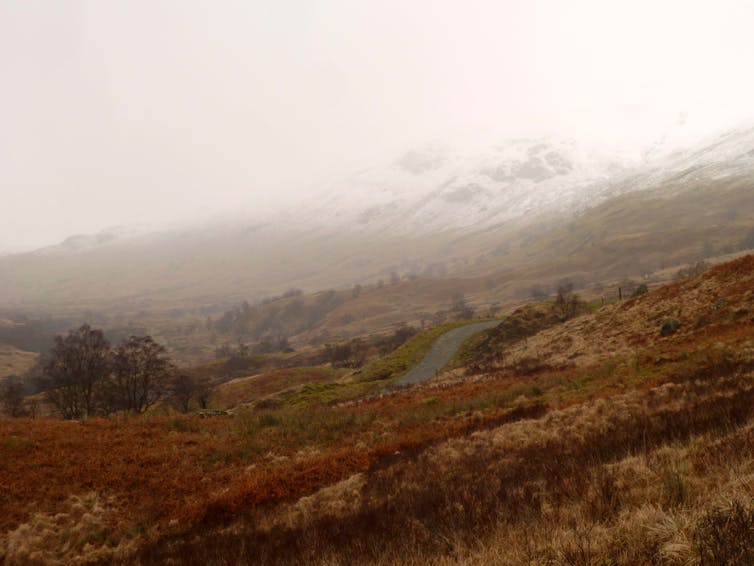
The experiment has six replicates of four grazing treatments and covers around 0.75km² of land, with 12km of fencing. This may not seem large, but in experimental terms, it is. According to Robin Pakeman, a researcher at the James Hutton Institute who manages the project, the experiment constitutes “an unrivalled resource to understand how grazing impacts on a whole range of organisms”.
Since the start, the Glen Finglas experiment has shown that grazing intensity affects plants and the amount of insects and spiders. The highest amount of plants, insects and spiders were found in the ungrazed areas. This was not too surprising as grazing livestock removes vegetation, which results in reduced habitat conditions for insects and spiders overall (although some species benefit from grazing).
There have also been studies on carbon storage, vole abundances and fox activity within the experiment. These have shown higher carbon storage and higher fox activity in the ungrazed areas.
Meanwhile, the research on birds within this experiment has, from the start, focused on meadow pipits. These small, brown birds are the “house sparrows of the uplands”, yet often go unnoticed. But they are the most common upland bird and an important part of upland food webs, forming key prey for birds of prey such as hen harriers and a common host for cuckoos. The experiment has provided unique insights into the ecology of this fascinating little bird, and a much clearer understanding of how it is affected by grazing.
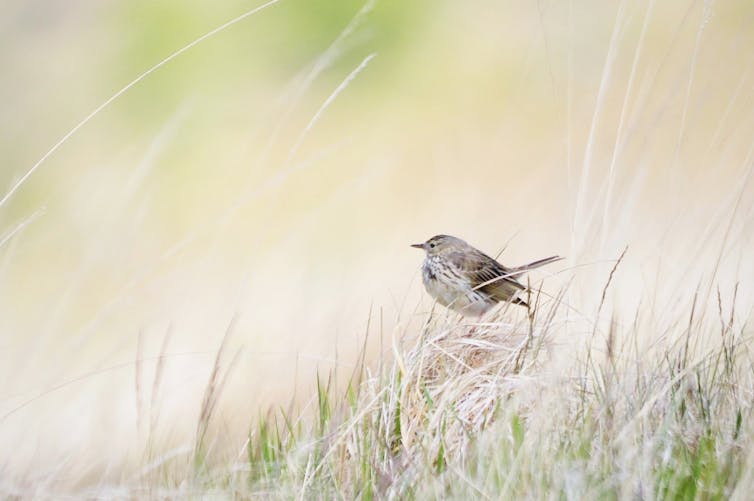
In just the first two to three years, it became clear that meadow pipits could be affected by grazing intensity. My PhD supervisor, Darren Evans, found that the breeding density and egg size were both positively affected by low intensity mixed cattle and sheep grazing. But there were no differences in how many meadow pipit chicks were produced and fledged between the grazing treatments, at least not in the very early phase of the experiment.
I wanted to test whether these results changed in the longer term. Together with colleagues from Newcastle University, the British Trust for Ornithology, The James Hutton Institute and The University of Aberdeen, we looked at whether 12 years of continuous experimental grazing management had affected the breeding success of meadow pipits.
We assumed that low intensity grazing, compared to high intensity or no grazing, was most beneficial for pipit breeding productivity. We found the low intensity grazed areas did indeed seem to be better for meadow pipits, but the effects were not clear enough to be statistically significant. And there seemed to be potentially more important factors, such as predation, affecting their breeding outcome.
But although we did not initially set out to test it, we found other, more significant, effects on the wider bird community.

Unexpected findings
When the experiment started, there were almost no bird species other than meadow pipits in and around the treatment areas, hence the focus on them. But in 2015, while looking for meadow pipit nests, we came across a few other beautiful nests in the low intensity grazed areas. These nests had colourful blue eggs or eggs that appeared to have been painted with dark brown watercolour paint. These turned out to be stonechat and reed bunting eggs, two bird species that had not previously been seen in the experiment.
Later on, we saw that they had fledged successfully: the parents would call them to warn about human intruders. If we didn’t get too close, the newly fledged young would curiously nudge their heads up through the vegetation. By this stage of the experiment – 12 years in – the vegetation had actually become quite dense and high in the ungrazed and some of the low intensity grazed areas.
We also detected several black grouse nests, mainly in the ungrazed areas. Most of them were already hatched, but one had a female who bravely stayed put on her eggs every time we visited this area until they hatched.
Another great discovery was when we found a meadow pipit nest with one egg that seemed oddly big in comparison to the rest of the clutch. We were really excited to realise that it had been visited by a cuckoo that had laid an egg there, which hadn’t happened during the early years of nest monitoring in the experiment. This egg had a brown spotted pattern which was fascinatingly similar to the meadow pipit eggs. (As exciting as this all may seem, nest searching should only be carried out under permit. I also had a bird ringing permit covering my research activities).
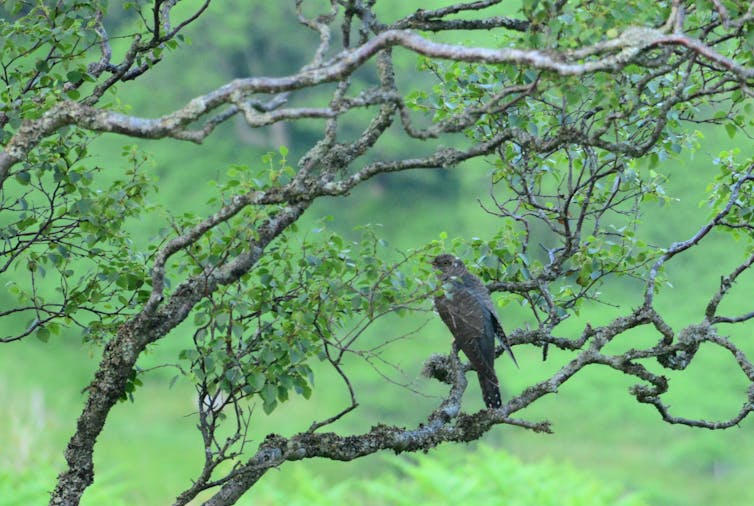
Thanks to all these encounters, we decided to test how the different grazing treatments affected the species richness of breeding birds. Over the first two years, we found that there was basically no difference. But another decade on and there were clearly more bird species found in the ungrazed areas compared to the other experimental plots.
A fractious debate
It was not only bird species richness that needed time to respond to the change in grazing management. Although plant structure responded early, it was not until 2017 – 14 years since the experiment began – that an effect on plant species richness could be detected. In this case, the variety of species was greater in the intensively grazed areas, probably because the livestock holds back fast-growing plants from dominating. Whether this would remain the same in another decade is far from clear.
The ungrazed areas in our study, meanwhile, showed more shrub and tall-growing plants after a bit more than a decade. There were also patches of deciduous tree species, which were not there when the experiment commenced.
Rewilding is such a fractious debate because of the difficulty in obtaining solid scientific evidence on which to base decisions. It takes a very long time – far longer than our political cycles, most research studies, perhaps even a lifetime – to determine what the ultimate effects of large scale land management on the environment are. In our experiment, changes have been very slow. Pakeman explained to me that this is partly expected in cold and infertile habitats but another reason for slow responses is that plant communities exist in a sort of “mosaic”, with each community having a different preference for the grazers. He continued:
The long history of grazing has meant that the most highly preferred communities show little response to grazing removal as they have lost species capable of responding to this change.
There is no one management practice which creates the perfect environment. Some bird species (skylark and snipe) were only found in grazed areas. Other species were more abundant in the ungrazed areas. There is no one size fits all.
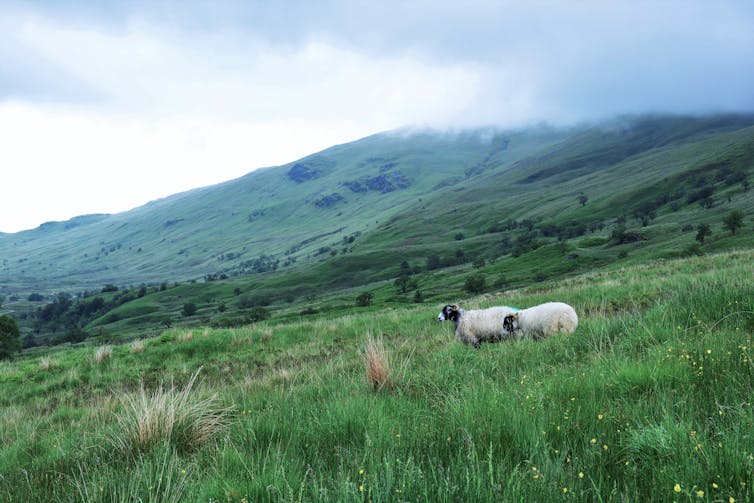
But much more consideration and effort needs to be given to unattended land and its potential for boosting biodiversity. There is no single answer to what is the best alternative, but our experiment indicates that a mosaic of different grazing types and shrub or woodland would be more suitable if the aim is to increase biodiversity, carbon uptake and habitats for endangered species.
The experiment also showed that changing the management had no effects on plant diversity and bird species richness in the first years. But this may only be the beginning of the transformation. Another decade of no grazing may result in even higher, or lower, species richness. This shows how important it is to be patient in receiving the effects of land management on plants and wildlife.
Using existing evidence
Our results bring some experimental evidence to the debate around sheep farming versus rewilding. Hopefully, decisions around new policies and subsidy systems will be based on such evidence. As new policies are formed, there will inevitably always be winners and losers, among both humans and wildlife, according to which habitat types receive more support.
Biodiversity is incredibly important. It creates a more resilient ecosystem that can withstand external stresses caused by both humans and nature. It also keeps populations of pollinators strong. At the moment, perhaps the most current and urgent reason is that it could be instrumental in protecting us from future pandemics. A wider range of species prevents unnatural expansions of single species, which can spill over their diseases to humans.
But preserving biodiversity is just one element of long-term environmental aims. Other processes, such as increased flood protection and carbon storage, which both can be achieved through more vegetation, may soon become more prevalent.

There are therefore several biological processes pointing towards public gain from increasing the area of unmanaged land. Across Europe, land is being abandoned due to low profitability in farming it. There are predictions that the amount of abandoned land in Europe will increase by 11% (equivalent to 200,000km² or 20 million ha) by 2030. This is often reported negatively, but it does not have to be. The problem most people see with land abandonment or rewilding is the decrease in food productivity, which will have to increase in order to feed a growing human population.
But as Richard Bunting at the charity Rewilding Britain explained to me, a decline in food production could be avoided, while increasing the areas subject to rewilding to 10,000km² (a million hectares) by the end of the century:We’re working for the rewilding of a relatively small proportion of Britain’s more marginal land. One million hectares may sound like a lot, but there are 1.8 million hectares [18,000km²] of deer stalking estates and 1.3 million hectares [13,000km²] of grouse moors in Britain. In England alone, there are 270,000 hectares [2,700km²] of golf courses.
As farmers and other upland land owners may be opposed to the idea of rewilding, I also asked him how this would work in practice. He told me that he believes farming and rewilding could work well together, but he had some caveats:
We do need conversations around fresh approaches to the way farming is carried out and how land is used. A key point here is that for farmers, engaging with rewilding should always be about choice, as we seek a balance between people and the rest of nature where each can thrive.
There are many ways to rewild. The Woodland Trust have been successful in restoring ancient woodlands and planting new trees by protecting them from large herbivores such as deer and livestock. Another method is to let “nature have its way” without intervening at all. This has been successful in restoring natural habitats, including woodland, such as the Knepp estate in West Sussex, which Isabella Tree has made famous in her book Wilding.
After 19 years of no conventional management, The Knepp estate now hosts a vast range of wildlife, including all five native owl species, the rare purple emperor butterfly and turtle doves. Large herbivores, including both livestock and deer, graze the area on a free-roaming level. These animals are replacing the large natural herbivores such as aurochs, wisent and wild boar which would have grazed the area thousands of years ago.
So there is room for discussion on what environmental and financial benefits there may be of different rewilding, or woodland restoration projects, and where they are most suitable.
The first thing to do, I think, is to diversify the types of land management championed by the government through subsidy. Natural habitats could be increased through more financial benefits to landowners for leaving land unattended, while improving public interest in visiting woodlands and thereby the support for preserving wild habitats.
Meanwhile, long-term research of land-use change would give us a better evidence base for future decisions. But this must go hand in hand with much needed serious evaluations of rural communities’ long-term income opportunities under alternative management scenarios, which will always be a cornerstone in land use politics.
Finding the people and the books transforming the future of society and business in positive ways
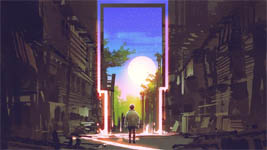
2020 has changed not only where people work from, but how they work and what tools they use. We are undoubtedly all trying to strike a balance between thinking about two very important realities: the now and the future. The recent pandemic has changed everything we know, particularly about how we remain socially connected. But as more countries begin to lift their lockdown measures, and as we navigate one crisis after another, it seems, we are faced with the problem of how to return to normal. And should we want to?
We want to find the people and the books that are already transforming the future of society and business, defining the new ways in which people are approaching their everyday tasks and mindsets.
Thinking about the future requires a diversity of views. We need to involve experts from many different domains. We need to include people who bring different perspectives on demographics, economics, technology, artificial intelligence, business organization, mental health, and more. We need young people in the room. A robust working future is a product of collective intelligence, according to the IFTF.
This is not about predicting the future, rather it is about engaging people in thinking deeply about complex issues, imagining new possibilities, connecting signals into larger patterns, connecting the past with the present and the future, and making better choices today.
For this contest, The Future Of, Publishizer and our partners are seeking topics from futurists, speakers, coaches, and forward thinkers on a broad range of well-defined topics, such as business, self-help, mindfulness, well-being, fitness, clean living, decluttering/organization, psychology and anxiety (especially kids and teens), eco-friendly/zero waste, retail, trees and birdwatching, homeschooling, productivity, true crime, nature-oriented, hidden histories, cultural trends, pop-science, and entrepreneurship.
Book ideas that aim to reshape or reimagine our future
Submissions open now until August 1, 2020
The Future Now Show
Shape the future now, where near-future impact counts and visions and strategies for preferred futures start. – Club of Amsterdam
Do we rise above global challenges? Or do we succumb to them? The Future Now Show explores how we can shape our future now – where near-future impact counts. We showcase strategies and solutions that create futures that work.
Every month we roam through current events, discoveries, and challenges – sparking discussion about the connection between today and the futures we’re making – and what we need, from strategy to vision – to make the best ones.
July / August 2020
A third way:
Self Sovereign Identity and Disposable Identities
with
Rob van Kranenburg

The Future Now Show
Credits
Rob van Kranenburg, Transition Coach, Belgium
Founder of Internet of Things Council
www.theinternetofthings.eu/rob-van-kranenburg
Project Dormio: Interfacing with Dreams

Photo: MIT
MIT’s Dream Lab
Project Dormio: Interfacing with Dreams
Overview
Sleep is a forgotten country of the mind; a vast majority of our technologies are built for our waking state, even though a third of our lives are spent asleep. Current technological interfaces miss out on an opportunity to access the unique, imaginative, elastic cognition ongoing during dreams and semi-lucid states. In turn, each of us misses an opportunity to use interfaces to influence our own processes of memory consolidation, creative insight generation, gist extraction, and emotion regulation that are so deeply sleep-dependent.
Inspiration
Sleep is a forgotten country of the mind. A vast majority of our technologies are built for our waking state, even though a third of our lives are spent asleep. Current technological interfaces miss an opportunity to access the unique, imaginative, elastic cognition ongoing during dreams and semi-lucid states. In turn, each of us misses an opportunity to use interfaces to influence our own processes of memory consolidation, creative insight generation, gist extraction, and emotion regulation that are so deeply sleep-dependent. In this project, we explore ways to augment human creativity by extending, influencing, and capturing dreams in Stage 1 sleep. It is currently impossible to force ourselves to be creative because so much creative idea association and creative incubation happens in the absence of executive control and directed attention. Sleep offers an opportunity for prompting creative thought in the absence of directed attention, if only dreams can be controlled.
Scientific Background
During sleep onset, a window of opportunity arises in the form of hypnagogia, a semi-lucid sleep state where we all begin dreaming before we fall fully unconscious. Hypnagogia is characterized by phenomenological unpredictability, distorted perception of space and time, and spontaneous, fluid idea association. Edison, Tesla, Poe, and Dalí each accessed this state by napping with a steel ball in hand to capture creative ideas generated in hypnagogic microdreams when it dropped to the floor below.
Engineering and Experimentation
In this project we modernize this technique, using an interactive social robot accompanied with a custom sleep stage tracking system, and auditory biofeedback. We are able to influence, extract information from, and extend hypnagogic microdreams for the first time: we found that active use of hypnagogia with the system can augment human creativity. This system enables future research into sleep, an underutilized and understudied state of mind vital for memory, learning, and creativity.
These Sleep Engineers Could Help You Hack Your Dreams
The machine that lets you control your dreams
News about the Future

Reshaping the retail experience
Based out of Tel Aviv, trigo’s team of world class experts is leading the forefront of the grocery industry.
Trigo is a computer vision startup reshaping the retail experience. Leveraging world-class AI and algorithmics experts, the company’s advanced retail automation platform identifies customers’ shopping items with exceptional levels of accuracy, creating an entirely seamless checkout process. Trigo’s technology streamlines retail operations, prevents shoplifting, provides invaluable retail insights, and presents opportunities for new levels of customer engagement within retail environments.
Trigo’s system consists of ceiling-mounted cameras and sensors powered by artificial intelligence that applies deep learning architecture. With this combination of hardware and software, we create a 3D image of the store and map the shoppers’ movements and their product choices. Using our unique 3D mapping capabilities, we provide an easy-to-integrate and highly-accurate system.

DNA testing kits directly to consumers
Genetic Researchers have started to identify which genes affect the onset of lifestyle diseases. Thus, a Genetic Test will allow you to understand which diseases you are at genetic risk of developing in the future.
Of the Genes that are already mapped, it is known that each individual has a 0.1% difference in the sequence. Since the genes do not change during one’s lifetime, you need to only test once. You can make better lifestyle choices based on your risk profile.
GeneLife‘s genetic testing services are brought to you by Genesis Healthcare Asia: a leader in genetic testing and research from Japan.
GeneLife offers a range of DNA testing kits directly to consumers, enabling users to assess potential hereditary health risks and lifestyle related conditions
Through our test reports and wellness recommendations, customers are empowered to know more about themselves and be informed about potential risks for the future. It allows them to make relevant proactive lifestyle adjustments to enhance their health. GeneLife offers a variety of genetic testing kits ranging from health, personality, diet and nutrition, beauty and skincare, sports and fitness as well as ancestry.
Fraunhofer UMSICHT – a pioneer for sustainable energy and raw materials management
Fraunhofer UMSICHT is a pioneer for sustainable energy and raw materials management by supplying and transferring scientific results into companies, society and politics.
Our society continuously consumes raw materials and energy. How else can we produce, consume, be mobile, heat or cool? In our projects, we ask ourselves: How can we protect the climate and the environment? How do we conserve resources? How do we improve processes or products? What does it cost? Under what conditions do companies implement processes that make industrial societies sustainable? When do people like to contribute to change? We consider what needs to change and what we can do to achieve it. We estimate costs, advise and highlight solutions.
Biofuel for ships
Ships are among the biggest climate sinners. Millions of tonnes of combusted marine diesel pollute the environment. The shipping industry is responsible for emitting around a billion metric tonnes of carbon dioxide worldwide each year. Dr. Andreas Menne, a mechanical engineer, and his colleagues at Fraunhofer UMSICHT in Oberhausen want to mitigate marine diesel’s adverse impact on the climate with a new technology. Menne, who heads up the Biorefinery and Biofuels department, and his team are producing synthetic diesel and gasoline made from renewable resources. To do so, they are converting bioethanol into diesel, gasoline or jet fuel that have nearly the same properties as fossil fuels. Renewables help slash the transportation sector’s CO2 emissions. “Straw, leaves, sawdust, waste wood – we can use almost anything as the feedstock for bioethanol,” says Menne. The new climate-friendly biofuel produces a lot less greenhouse gas. Vehicles should be able to run on nothing but this fuel. By contrast, just five to ten percent of the E10 fuel is bioethanol; the rest is of fossil origin. “We’re not going to feel much of a climate effect with that,” says Menne. “Electric, hybrid and fuel-cell vehicles are not going to reduce greenhouse gas emissions as quickly as this has to happen. We need a holistic approach and a diversity of solutions for tomorrow’s fuels.” The pressure to take action is mounting with the revised Renewable Energies Directive (RED II) calling for advanced fuels to account for a share of 3.5 percent by 2030. The share of alternative fuels based on food crops is to be reduced by the same percentage.
Bioethanol made of wheat straw
The UMSICHT researchers are producing up to 20 liters of the new biofuel a week in an experimental plant. The feedstock is bioethanol sourced from wheat straw. “Actually, I could use any other alcohol,” says Menne. The straw alcohol initially retains its liquid form as it flows from the metal drum through the pipes of the test plant into a vaporizer. When the temperature reaches 350 degrees Celsius at a pressure of 20 bar, the gaseous alcohol flows into the heart of the plant, a tubular reactor. This reactor is filled with pieces of activated carbon coated with a newly developed catalyst material. These catalysts cause the gas to condense by forming bonds between individual carbon compounds. This produces gasoline, kerosene or diesel, depending on how many carbon molecules are combined. “A catalyst is often developed in the lab but may then turn out to be difficult to produce in large quantities. But we can buy the materials for this catalyst cheaply because it doesn’t consist of precious metals or rare earths. And most importantly, it remains stable over the long term,” says Menne.
The biofuel packs plenty of power, as researchers at the Fraunhofer Institute for Chemical Technology ICT in Pfinztal have confirmed. They put standard commercial engines on a test bench to run trials with the new fuel, rate engine power and measure waste gases with precision instruments. These readings were taken at different operating levels, during cold starts, under different loads and at varying engine speeds.
Tests confirm low waste gas emissions
These trials found the biofuel’s energy density to be slightly higher than that of conventional fuels. That means a vehicle with this new fuel in its tank would have a slight advantage in a real race. The synthetic fuel’s waste gas emissions were also a selling point with less carbon monoxide, carbon dioxide and hydrocarbons, and a lot less soot emanating from the exhaust. This biofuel’s physical properties come close to those of fossil diesel, so it can be made to comply with prevailing standards.
Venkat Aryan, a chemical engineer at Fraunhofer UMSICHT, has added up every molecule of the greenhouse gases in each process step to assess the ecological impact. A well-to-wheel analysis factors all greenhouse gases into the equation, from the extraction or harvesting of raw materials to the fuel’s conversion into kinetic energy. This includes crude oil extraction from underground wells, the cultivation of plants for biofuel and the waste gases. He found that the CO2 equivalents for synthetic diesel made from wheat straw amounted to 64.3 to 91.6 grams per megajoule, depending on the ethanol source. That is up to 32 percent less than the 94 grams for petroleum-based diesel.
Shipping companies can make their own biofuel
“Our fuel can be converted into gasoline, diesel or even kerosene for airplanes. But the latter is the most complicated,” says Menne. Marine diesel is a much simpler matter. It does not have to be processed in a refinery. “You could simply set up our plant in a port. Our process is so straightforward that shipping companies could produce their own diesel. Then the age of the big stinkers would soon be over,” says Menne.
The technology is ready to go to market. While the synthetic diesel is still more expensive than diesel made of petroleum, Menne is confident that this could soon change. As the new legislation takes effect, fossil fuels will no longer be as cheap to produce.
Some videos
Bioplastics | How plastics become sustainable
This is how a circular economy for plastics works
CO2 reduction in the steel and chemical industries
Recommended Book
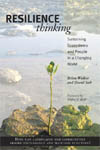
Resilience Thinking: Sustaining Ecosystems and People in a Changing World
By (author) Brian Walker,(author) David Salt, Foreword by Walter V. Reid
Increasingly, cracks are appearing in the capacity of communities, ecosystems, and landscapes to provide the goods and services that sustain our planet’s well-being. The response from most quarters has been for “more of the same” that created the situation in the first place: more control, more intensification, and greater efficiency. “Resilience thinking” offers a different way of understanding the world and a new approach to managing resources. It embraces human and natural systems as complex entities continually adapting through cycles of change and seeks to understand the qualities of a system that must be maintained or enhanced in order to achieve sustainability. It explains why greater efficiency by itself cannot solve resource problems and offers a constructive alternative that opens up options rather than closing them down. In “Resilience Thinking”, scientist Brian Walker and science writer David Salt present an accessible introduction to the emerging paradigm of resilience. The book arose out of appeals from colleagues in science and industry for a plainly written account of what resilience is all about and how a resilience approach differs from current practices.
Rather than complicated theory, the book offers a conceptual overview along with five case studies of resilience thinking in the real world. It is an engaging and important work for anyone interested in managing risk in a complex world.
Electric Oil Tankers & Batteries in EVERYTHING
by Fully Charged
Robert Llewellyn is all alone in a field or to be more professional, the field studio. Where he talks about the latest news about Electric Oil Tankers – yes we feel the irony too. What are they used for and where? Robert also talks about bidirectional charging in Teslas, the wiring is there so it seems, so can we use our Model 3’s to live on in our dwellings?
Glass Batteries might be the key to getting renewable energy sources in everything. Oat Milk by EV? Yes, one of the biggest oat milk providers is determined to transport their produce with EVs.
Finally, are car dealerships finally realising the power of EV car sales?
Climate Change Success Story:
Farming for Conservation – The Burren Programme

The Burren Programme has developed over a number of years — way back since the 1990s in fact — and evolved through various forms during this time. The success of the programme is built on the input of a lot of people and organisations over a long time, and required a great deal of patience, commitment and mutual respect on the part of all those involved as they pursued a shared vision for the future of the Burren and its people.
Identifying the issues
The first seeds of the programme were sown in the late 1990s when local farmers, in conjunction with Teagasc, University College Dublin and the National Parks and Wildlife Service, came together to agree on a research project into The Impact of Agricultural Practices on the Natural Heritage of the Burren. This PhD research project was later published by Teagasc in book form as Farming and the Burren (Dunford, 2001). It highlighted the important role that farming plays in supporting the rich biodiversity and cultural heritage of the Burren, and also the worrying breakdown in traditional farming systems and the habitats dependent on them.
Testing solutions
The original partners — NPWS, Teagasc and Burren IFA — came together again in 2004 to secure funding from the EU LIFE fund to try to address some of the problems identified in the initial research project, and to develop ‘A blueprint for the sustainable agricultural management of the Burren’. This ‘BurrenLIFE project’ (2005–2010) was the first major farming for conservation project in Ireland and one of the very few EU projects which placed farmers at the centre of the conservation agenda. Working on 20 Burren farms (c.2,500ha) over a number of years, the Burren LIFE project successfully developed a tested, costed blueprint for the Burren and paved the way for the roll-out of a new programme to tackle the most pressing issues impacting on the region.
Implementing solutions
Arising from the success of the BurrenLIFE project, the Burren Farming for Conservation Programme (BFCP) was launched in 2010 by its funders, the Dept. of Agriculture, Food and the Marine and the NPWS of the Dept. of Arts Heritage and the Gaeltacht. The BFCP ran from 2010 to 2015. It worked with 160 farmers on 15,000ha of prime Burren habitat. It built directly on the lessons learned during BurrenLIFE and worked in a very creative way to support and incentivise farmers to maintain and enhance the habitats of the Burren, effectively tackling many of the issues identified in the original research project over a decade previously. The Burren Programme, started in 2016 with 200 farmers, and has now grown to 328 farmers, is a natural progression of the BFCP and will continue to work closely with farmers, advisors and the EU, DAFM and NPWS to implement solutions to help manage and protect the Burren.

Futurist Portrait: Andy Lowe
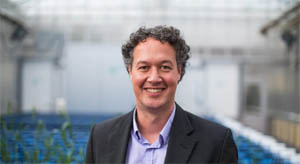
Prof Andy Lowe, food futurist, is a British-Australian scientist and expert in plants and trees, particularly the management of genetic, biological and ecosystem resources. He has discovered lost forests, championed to eliminate illegally logged timber in global supply chains, served the United Nation’s Office of Drugs and Crime and is a lead author of the Intergovernmental Platform for Biodiversity and Ecosystem Services – Land Degradation and Restoration report.
He has helped secure a quarter of a billion dollars worth of research funding in his field and is an experienced and respected executive leader, board member, as well as mid-career mentor. Andy has been the Scientist in Residence at The Australian Financial Review since August 2018.
Andy is inaugural Director of Agrifood and Wine at the University of Adelaide serving as the external face for food industry and government sector partnerships across Australia, and the world.
“If you’re passionate about the journey of food, biological resources, sustainability and innovation, then you’ve come to the right place! Prof Andy Lowe tackles questions about how the food we eat is grown, consumed, protected, and even wasted.”
Andy has a new podcast Food Futurists with season one boasting interviews with the likes of Howard Yana-Shapiro of Mars Inc, and Marco Gualtieri of the biggest global food summit around, Seeds&Chips.
Andy: “I’ve been fortunate enough to be appointed as Director of Food Innovation at the University of Adelaide to help grow the research and teaching across the food sector. The University has extraordinary breadth and depth of research and teaching capability, with over 250 academic staff working on food-related areas. Its been a real pleasure working with this group.”



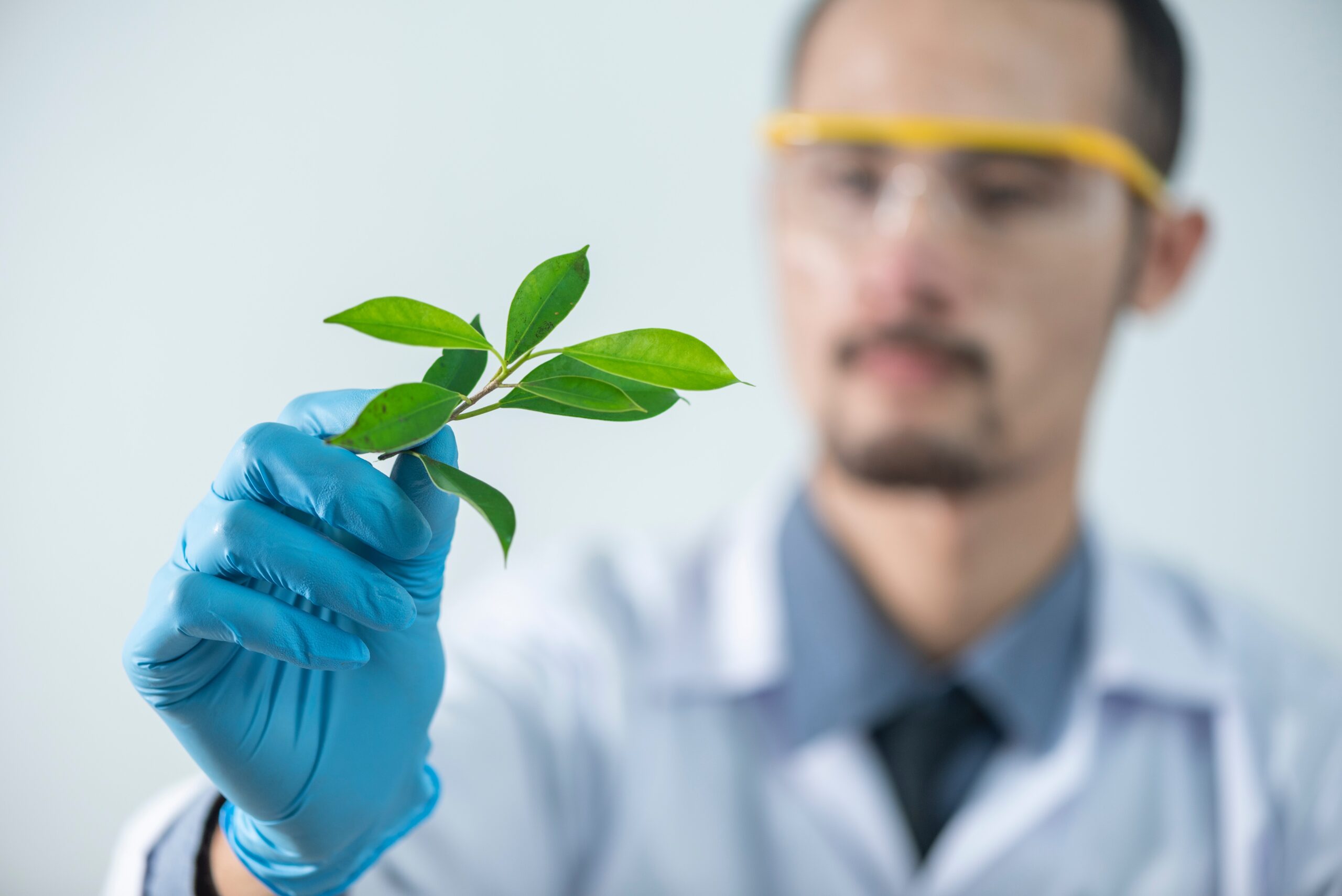


Customer Reviews
Thanks for submitting your comment!